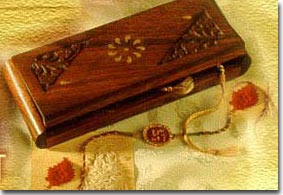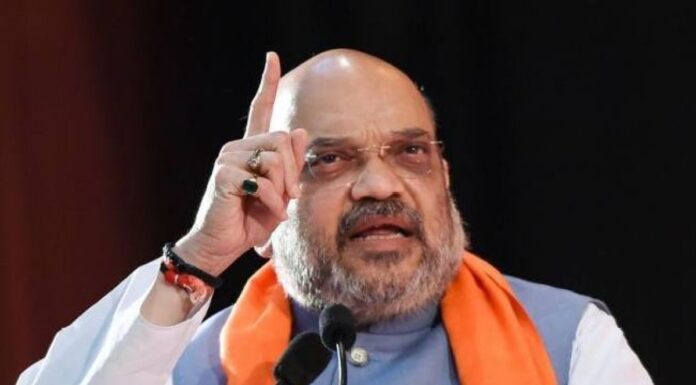|
पर्व परिचय—–Rakshabandhan../रक्षाबंधन —
|
|
 |
बंधन धागों का —-
|
|
रक्षाबंधन का त्योहार श्रावण मास की पूर्णिमा को मनाया जाता है। भगवान विष्णु ने वामन अवतार धारण कर बलि राजा के अभिमान को इसी दिन चकानाचूर किया था। इसलिए यह त्योहार ‘बलेव’ नाम से भी प्रसिद्ध है। महाराष्ट्र राज्य में नारियल पूर्णिमा या श्रावणी के नाम से यह त्योहार विख्यात है। इस दिन लोग नदी या समुद्र के तट पर जाकर अपने जनेऊ बदलते हैं और समुद्र की पूजा करते हैं।
रक्षाबंधन के संबंध में एक अन्य पौराणिक कथा भी प्रसिद्ध है। देवों और दानवों के युद्ध में जब देवता हारने लगे, तब वे देवराज इंद्र के पास गए। देवताओं को भयभीत देखकर इंद्राणी ने उनके हाथों में रक्षासूत्र बाँध दिया। इससे देवताओं का आत्मविश्वास बढ़ा और उन्होंने दानवों पर विजय प्राप्त की। तभी से राखी बाँधने की प्रथा शुरू हुई। दूसरी मान्यता के अनुसार ऋषि-मुनियों के उपदेश की पूर्णाहुति इसी दिन होती थी। वे राजाओं के हाथों में रक्षासूत्र बाँधते थे। इसलिए आज भी इस दिन ब्राह्मण अपने यजमानों को राखी बाँधते हैं। रक्षाबंधन का त्योहार भाई-बहन के पवित्र प्रेम का प्रतीक है। इस दिन बहन अपने भाई को प्यार से राखी बाँधती है और उसके लिए अनेक शुभकामनाएँ करती है। भाई अपनी बहन को यथाशक्ति उपहार देता है। बीते हुए बचपन की झूमती हुई याद भाई-बहन की आँखों के सामने नाचने लगती है। सचमुच, रक्षाबंधन का त्योहार हर भाई को बहन के प्रति अपने कर्तव्य की याद दिलाता है। राखी के इन धागों ने अनेक कुरबानियाँ कराई हैं। चित्तौड़ की राजमाता कर्मवती ने मुग़ल बादशाह हुमायूँ को राखी भेजकर अपना भाई बनाया था और वह भी संकट के समय बहन कर्मवती की रक्षा के लिए चित्तौड़ आ पहुँचा था। आजकल तो बहन भाई को राखी बाँध देती है और भाई बहन को कुछ उपहार देकर अपना कर्तव्य पूरा कर लेता है। लोग इस बात को भूल गए हैं कि राखी के धागों का संबंध मन की पवित्र भावनाओं से हैं। |
|

Meaning & Significance of Raksha Bandhan–
The Meaning of Raksha Bandhan—
Relationships are the essence of any festivity and it holds true for any Indian festival. Each occasion brings the family together which calls for a celebration. Raksha Bandhan is a celebration of one such relation – that of a brother and a sister. This relationship is no where so celebrated as in India. Raksha Bandhan is a festival which celebrates the bond of affection between brothers and sisters. It is a day when siblings pray for each others’ well being and wish for each others’ happiness and goodwill.
The name ‘Raksha Bandhan’ suggests ‘a bond of protection’. On this auspicious day, brothers make a promise to their sisters to protect them from all harms and troubles and the sisters pray to God to protect their brother from all evil. The festival falls on the Shravan Purnima which comes generally in the month of August. Sisters tie the silk thread called Rakhi on their brother’s wrist and pray for their well being and brothers promise to take care of their sisters.
The Significance
Raksha Bandhan is now considered as a day to celebrate the sacred relation of a brother and a sister. Yet there have been examples in history where in rakhi has just been a raksha or protection. It could be tied by wife, a daughter or mother. The Rishis tied rakhi to the people who came seeking their blessings. The sages tied the sacred thread to themselves to safe guard them from the evil. It is by all means the ‘Papa Todak, Punya Pradayak Parva’ or the day that bestows boons and end all sins as it is mentioned in the scriptures.
Previously, Rakhi festival encompasses the warmth shared between the siblings but now it goes way beyond it. Some people tie Rakhi to neighbours and close friends signifying a peaceful co-existence of every individual. Rakhi Utsav was first popularized by Rabindranath Tagore to promote the feeling of unity and a commitment to all members of society to protect each other and encourage a harmonious Social life.
In today’s scenario, the day has a different perspective. The occasion involves a pledge of life-time practice of moral, cultural and spiritual values. The values and the sentiments attached to the rituals of this festival are worth inculcating by the whole human race, the sentiments of harmony and peaceful coexistence. The festival of Raksha Bandhan assumes all forms of Raksha or protection, of righteousness and destroyer of all sin. The ritual of Rakhi tying has become so important that come what may, brothers and sisters try to visit each other place on this particular day tin order to bring back the oneness of the family, binding the family together in an emotional bond of love.
भाई-बहन के स्नेह का पर्व रक्षाबंधन |
|||||||||
|
|||||||||
 |
भाई-बहन का लगाव व स्नेह ताउम्र बरकरार रहता है, क्योंकि बहन कभी बाल सखा तो कभी माँ तो कभी पथ-प्रदर्शक बन भाई को सिखाती है कि जिंदगी में यूँ आगे बढ़ो।
Regional Names of Raksha Bandhan—-
The diversity which is so much a part of the Indian culture has led to Rakhi being adapted in different ways across the length and breadth of this vast nation. The regional influences are the reason for these variations in the customs and traditions of Rakhi. In fact, in many regions, Raksha Bandhan holds a different meaning altogether.
Here we present the many names with which people of Indian origin know this cultural festival.
Rakhi – This is probably the most widely known identity of Raksha Bandhan. Rakhi is also the name of the thread which sisters tie on their brothers hands. It is the token of raksha or protection on which brothers take the pledge or promise to protect their sisters.
Rakhi Purnima – Another name for this famous Indian festival. This occasion is known as Rakhi Purnima as it falls on the full moon day or puranmasi or purnima of the month of ‘Shravana’ as per the Hindu calender. The month of Shravana is the month of gods and pujans (worships) and the full moon day is considered one of the most important days of all.
Nariyal Purnima – Rakhi or Raksha Bandhan is also called Nariyal Purnima which in Hindi literally means coconut full moon. In the Western Ghats that includes the states of Gujarat, Maharashtra, Goa and Karnataka Rakshabandhan signifies the beginning of a new season for people whose lifestyle and livelihood depends on sea.
Upakarmam/Avani Avittam – Rakhi Purnima is called Avani Avittam or Upakarmam in southern parts of India, in Kerala, Andhra Pradesh, Tamil Nadu and parts of Orissa. It is an auspicious occasion for the Brahmins of these regions. The day is also called Upakarmam by the Brahmins who change their holy threads on this day.
Kajari Purnima – In Madhya Pradesh, Chattisgarh, Jharkhand and Bihar, Rakhi is known as Shravani or Kajari Purnima. Rakshabandhan here is an important day for farmers and for the sons in every family.
Pavitropana – The festival of Rakshabandhan is celebrated as Pavitropana in Gujarat. This is the day when people perform a grand pooja or worship the three eyed God, Lord Shiva. It is also the culmination of prayers done throughout the year.
Observance
Historical occurrences and mentions—-
Krishna and Draupadi—-
King Bali and Goddess Laxmi—-
Yama and the Yamuna—-
Alexander the Great and King Puru—-
Two important festivals are celebrated during the bright fortnight in the month of Shravan. One is known as Upakarma ( see page ‘Sacred Thread’ and also page ‘Sacraments’ Upanayan Samskar) and the other as Raksha Bandhan.
Shravan purnima’s second festival is Raksha Bandhan. This is an ancient tradition. Bhavishya Purana refers to a battle between gods and demons, and Indra (the king of the gods) was feeling depressed. At that time Indra’s wife Sachi took a thread, charged it with sacred verses or Mantras for protection and tied it on Indra’s hand. Through the strength of this thread Indra conquered his enemies. Since then till today this festival is celebrated.
Through the passage of time festivals are undergoing modifications. Raksha Bandhan is also known as Rakhi. Rakhi has become a sacred festival for sisters and brothers. Sisters tie them to brothers. Priests tie them to people of his congregation. During the middle ages, if a woman tied a Rakhi on the hand of any man, then it became imperative for him, as his religious duty of the highest order, to protect that woman. That man would put his life at stake to protect the honour of that woman.
In those days, many Rajputs sacrificed their lives to protect their spiritual sisters. Humayun received a Rakhi from the queen Karmavati of Chittor and for that, Humayun carried out his sacred brotherly duty and protected her by opposing his own soldiers.
According to ancient traditions, it is customary to have protection threads that are charged with sacred verses (Mantras) and sanctified with rice, durva grass etc.; to have these tied by people who know the Vedas or by near and dear ones. This protection thread saves from sins on the one hand and removes diseases on the other hand. By tying this thread, protection is afforded for a full one year and all kinds of fears are removed.
Nowadays Rakhis are decorated with soft silky threads of various colours, and also with ornaments, pictures, gold and silver threads etc. These Rakhis enhance the artistry of the people. Within these Rakhis reside sacred feelings and well wishes. It is also a great sacred verse of unity. Acting as a symbol of life’s advancement and a leading messenger of togetherness.
Each person should celebrate with enthusiasm this sacred festival of Rakhi or Raksha Bandhan. (Raksha = protection. Bandhan = tie).







